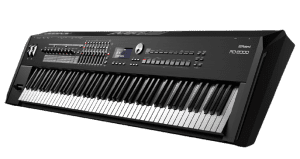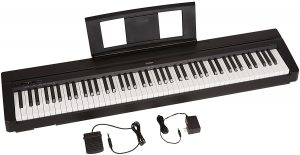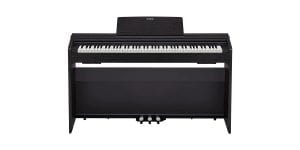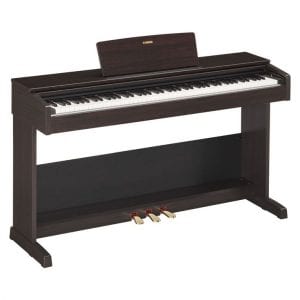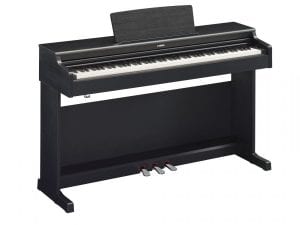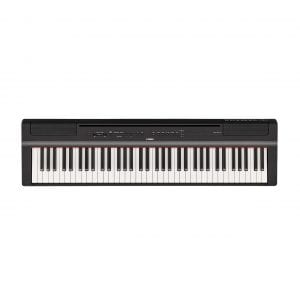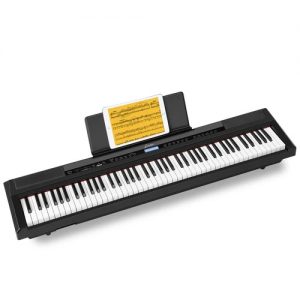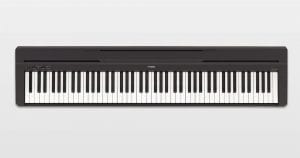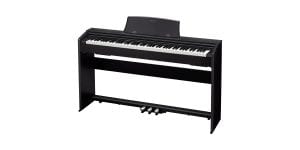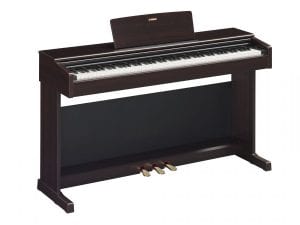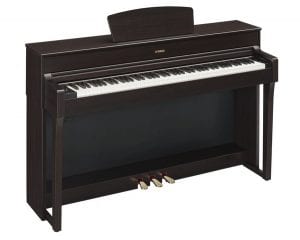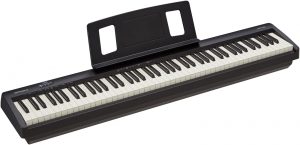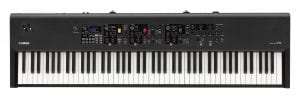Looking for Best Digital Pianos? Choosing on your own will be difficult as many quality pianos are available in the market, so you can take our help as we have compiled a list with unbiased digital piano reviews, and being honest we have shared the pros & cons of each piano to make it easier for you.
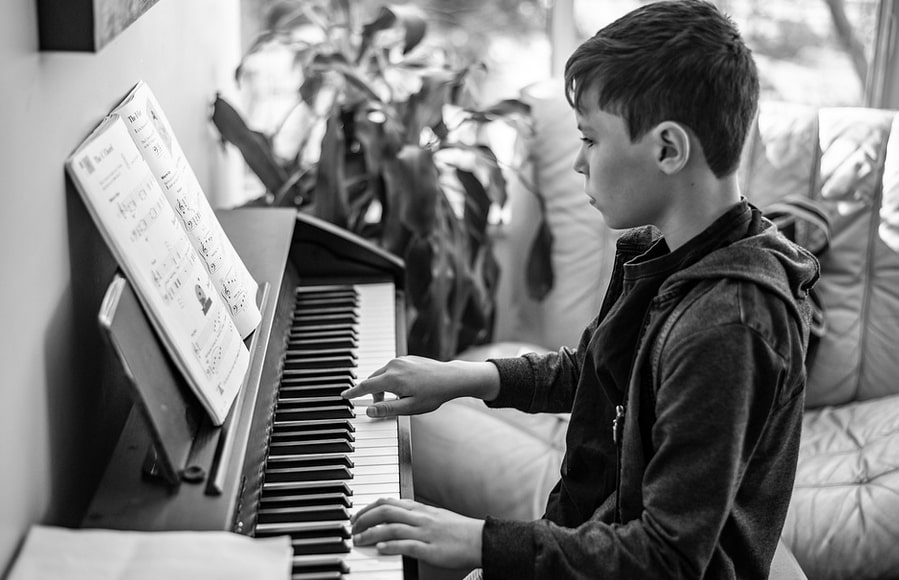
Quick Summary: Best Digital Pianos 2023
Choose the best digital piano based on your skill, budget, and need.
Highly Recommended
Roland RD-2000, Yamaha P71, and Casio Privia PX-870 are three of the best-rated digital pianos that can perfectly suit any skill level. Although, these are recommended to intermediates and experts only. For beginners, Alesis Recital Pro and Donner DEP-20 are better options as they are specially designed to help you learn quickly.
Table of Contents
- Top 15 Best Digital Piano Reviews 2023
- 1. Roland RD-2000 -Best Premium Digital Keyboard
- 2. Yamaha P71 – Best Digital Piano For Home (Under $500)
- 3. Casio Privia PX-870 – Best Digital Piano For Home (Under $1000)
- 4. Yamaha Arius YDP-103 – Best Digital Piano Under $900
- 5. Alesis Recital Pro – Best Digital Piano For Beginners (Under $400)
- 6. Yamaha YDP164 – Best Digital Piano For Professionals (Under $1500)
- 7. Yamaha P121 – Best Digital Piano – Compact
- 8. Donner DEP-20 – Best Digital Piano (Under $500)
- 9. Yamaha P45 – Best Digital Piano for the Money
- 10. Yamaha P515 – Most Realistic and Best Digital Piano (Under $1500)
- 11. Casio Privia PX-770 – Best Digital Piano Console Under $700
- 12. Yamaha Arius YDP-144 – Best Digital Piano for Intermediate Players (Under $1100)
- 13. Yamaha YDP184 – Great Choice for Professionals
- 14. Roland FP-10 – Great Entry-Level Digital Piano (Under $500)
- 15. Yamaha CP88 – Best Digital Piano For Stage (Under $2500)
- Digital Piano Buying Guide
- What is a Digital Piano?
- Types of Digital Piano
- Top 5 Reasons to Buy a Digital Piano
- Factors to Consider Before Buying a Digital Piano
- How Our Digital Piano Reviews Will Help You?
- Acoustic Vs. Digital Piano: How to Choose?
- Terminology for Digital Pianos
- Questions to Ask When Choosing a Digital Piano
- You Might Also Like
Top 15 Best Digital Piano Reviews 2023
1. Roland RD-2000 -Best Premium Digital Keyboard
A pianist looking for trendy creativity opts for the Roland RD-2000 premium 88-key digital stage piano. Well-developed with cutting-edge control features, two independent sound engines, and premium action Roland RD 2000 delivers incomparable performance. The flawless acoustic piano sound engine accompanied by Roland advancements delivers a rich, authentic, detailed tone with complete polyphony.
There are eight knobs with LED status indicators together with nine sliders that help in real-time control of effects and sounds. These knobs come with LED indicators that help in adjustments with visual feedback. The hybrid keys with molded material and wood deliver an authentic piano touch under your fingers.
To develop astounding music, eight assignable zones help in combining internal and external sources. The Roland RD-2000 comes with super natural-based sound engines having 128 voice polyphony for additional sound and electric pianos. A real authentic keyboard performance is brought out live on stage without compromises with full keyboard polyphony. With an intuitive interface, the PHA keyboard comes with a molded construction and hybrid wood for lasting durability and premium touch.
Live stand unique performance with 1100 non-piano sounds, with synths, brass, string, and organs. There is no doubt in loading additional sounds as it holds a two-wave slot expansion facility. The Roland RD-2000 weighs 47.1 pounds and is compact to carry anywhere anytime.
What’s Best in Roland RD-2000?
- Long-lasting durability due to molded construction and hybrid wood.
- Less power consumption
- Light-weight stage piano and reasonably priced
What’s Lacking in Roland RD-2000?
- The MIDI and audio are a bit complicated.
2. Yamaha P71 – Best Digital Piano For Home (Under $500)
| Features | Rating |
| Performance and sounds | 9.5 |
| Connectivity | 9.1 |
| Build Quality | 9.1 |
| For Beginners | 9.7 |
| Value for money | 9.6 |
The P71 is an exclusive model from Yamaha that features a power adapter and a sustain pedal. It comprises 88-fully weighted keys that simulate the feel of an acoustic piano. You can be sure to get a quality playing experience with this piano, which is capable of emitting ten different voices, that also incorporates sampled tones from the acoustic grand pianos of the Yamaha brand.
You can also combine two voices such as string sound with piano to offer an inspiring playing experience. The piano has a stylish and slim design and can fit perfectly in tight spaces and weighs less than 25 pounds.
The Yamaha P71 serves as an exclusive model that has been designed to be a perfect home digital unit for rehearsing, learning, and creating good music.
The piano is sure to fill your home with realistic music and has a very simple operation with just a button touch.
What’s Best in Yamaha P71?
- Graded hammer keyboard for the aspiring pianist
- Comes with a USB port, sustain jack, and also a headphone jack
- Affordable piano
- The sound that this piano produces is soft and great
What’s Lacking in Yamaha P71?
- Doesn’t support the MIDI format
- The sustain pedal doesn’t seem to function properly.
Check out: Best Digital Pianos for Learning
3. Casio Privia PX-870 – Best Digital Piano For Home (Under $1000)
An extremely elegant, highly functional, and one of the best digital pianos that come as a bundle in white with a padded bench, instruction books, and a DVD manual. It features an 88-scaled hammer action keyboard with ebony and ivory texturing. The keyboard comes as a stylish and modern wooden cabinet with a sliding cover for the keys.
You will be stunned by the sound that this piano makes with detailed resonance. Its four-speaker sound projector system is good enough to fill a complete room with some good music.
The keyboard is also packed with some of the most versatile tools for practice, recording, and performance. The best advantage of buying this piano is that it comes as a single bundle, comprising everything you would require to start playing, thus saving your budget and your time. The Privia PX-870 is a renowned line of digital pianos in the Privia range of Casio.
No doubt it has been designed in a way to offer a true experience of a grand piano for the pianist. It helps with authentic sounds and feels, in a stylish modern design along with a powerful sound projection system. It is thus a brilliant instrument to inspire the best music out of the pianist.
What’s Best in Casio Privia PX-870?
- The AiR Sound Source includes a four-layer stereo of a grand piano with damper resonance that feels so real.
- The PX-870 includes string resonance to add authenticity to the music play.
- The piano offers 19 instrument tones, with the ability to layer and split them.
What’s Lacking in Casio Privia PX-870?
- The piano cabinet is not solid wood
Check out: Best Home Digital Pianos
4. Yamaha Arius YDP-103 – Best Digital Piano Under $900
| Features | Rating |
| Performance and sounds | 9.6 |
| Connectivity | 9.2 |
| Easy to Assemble | 9.7 |
| Build Quality | 9.2 |
| Value for money | 9.6 |
The YDP-103 features a traditional Advanced Wave Memory technology that helps in delivering realistic piano sounds. AVM is a technology that makes use of digital recordings of grand acoustic instruments, thus allowing you to play the nuances of great pianos from a simple and small cabinet. Its Graded hammer system keyboard is ideal for aspiring pianists, as it helps them to build proper finger techniques.
Its half-damper pedal control helps in creating more detailed nuances and is similar to pedaling on a grand piano. You can connect the piano with the mobile phone app and access all of its features quickly and easily. The piano also helps you to combine two different voices, namely strings and piano sounds for rendering a new playing experience.
The piano comes as a complete package and renders you all the essentials to start playing the piano right out of the box. The piano comes with a bench, to help you play the instrument in absolute comfort. There is also a DVD that comes with the piano, to help you with the music lessons.
What’s Best in Yamaha Arius YDP-103?
- The matte finish on the keys helps in absorbing sweat efficiently while playing for long hours.
- Half-damper pedals help to play detailed notes more cleanly and perfectly.
- A great piano that sounds and feels like an acoustic piano
What’s Lacking in Yamaha Arius YDP-103?
- The piano can be slightly heavy and thus needs assistance for assembling
5. Alesis Recital Pro – Best Digital Piano For Beginners (Under $400)
| Features | Rating |
| Performance and sounds | 9.3 |
| For Beginners | 9.6 |
| Connectivity | 9.1 |
| Build Quality | 8.9 |
| Value for money | 9.4 |
Ultimately chic in its look, The Alesis Recital comes with 88 full-sized hammer action keys along with the digital response. Beginners desiring to play professional keys can opt for this full-featured digital piano. The best facet of Alesis Recital is its extraordinary educational features and 12 voices crafted proficiently.
The Alesis Recital has incredibly beneficial educational features such as split, standard, record, layer, and lesson mode. It also features a built-in FX: modulation, reverb, and chorus along with 128-note Max polyphony.
The connectivity is a must-discuss feature as it comes with an awesome 20W speaker, ¼” stereo headphone output beneficial for private practice, and ¼” sustain pedal input. Along with this it also features a stereo output to connect to an amplifier, mixer, recorder, and another sound system for loud music.
You would be amazed to receive skoove premiums with the piano with a catalog that holds classic to current hits. The skoove 3-month premium subscriptions delight beginners as they possess skillful interactive online piano lessons. Weighing about 32.6 pounds, the Alesis recital pro is neatly packed in a trendy wooden case. The Digital piano arrives with everything to start playing hence saving your time and budget as well.
What’s Best in Alesis Recital Pro?
- The 20 W speakers and 128 note max polyphony are ultimate that offer realistic sound and fill the room.
- To adjust from 30-280 beats per minute, a built-in metronome is available.
- Worth the price for outstanding quality
What’s Lacking in Alesis Recital Pro?
- It doesn’t have a pitch blend.
Check out: Best Digital Pianos & Keyboards for Beginners
6. Yamaha YDP164 – Best Digital Piano For Professionals (Under $1500)
| Features | Rating |
| Performance and sounds | 9.6 |
| Connectivity | 9.2 |
| Easy to Assemble | 9.7 |
| Build Quality | 9.4 |
| Value for money | 9.6 |
Yamaha is a leader in creating pianos for the most prestigious concert halls in the world. The Arius series of Yamaha recreates the touch of an acoustic piano to fill your life and your home with some concert grand sound. One best features that you will get from this YDP164B piano is its grand tone.
It recreates the iconic Yamaha CFX sound with its state-of-the-art recording methods. This piano features the 88-key hammer action keyboard with a three-pedal unit and a bench. Its weighted action keyboards resemble the acoustic piano and the keys have a special matte finish on their top.
Its half-damper pedal helps to sustain sounds and you can connect with the smart pianist app for taking complete control over the major functions of the piano. The innovative virtual resonance of the soundboard emulates the natural sound of an acoustic piano. The Arius has exceptional curves and a stylish design and its weighted keys produce a controlled and responsive touch to help you become an expert in this digital piano. Overall, it is an excellent piano for both professional and recreational pianists.
What’s Best in Yamaha YDP164?
- The matte texturing on the keys absorbs moisture and prevents the keys from getting slippery
- The piano has a complete three-pedal unit.
- Its dual headphone jacks make playing and practicing on this piano great fun.
What’s Lacking in Yamaha YDP164?
- Very heavy to handle by self, needs company for assembling.
7. Yamaha P121 – Best Digital Piano – Compact
| Features | Rating |
| Performance and sounds | 9.6 |
| Easy to Assemble | 9.8 |
| Connectivity | 9.2 |
| Build Quality | 9.1 |
| Value for money | 9.5 |
The Yamaha P121 is a more portable and lighter version of the Yamaha P125. It is a fully weighted digital piano with a complete set of 73 keys. Its graded weighted action makes this be perceived as an acoustic piano. Its pure CF sound engine enables it to reproduce the tone of Yamaha’s 9’ CFIIIS concert grand piano. The piano has USB-to-host connectivity with MIDI and audio transfer features to connect the piano to your music software.
Though this is a very lightweight piano, it offers an incredible design with optimal performance and several user-friendly features. The keyboard is easily portable and extremely accessible and though it is smaller than other 88-key pianos, it never falls short of tone, features, and touch. The piano has a newly improved two-way speaker system that helps in producing expansive piano sound in both the upward and the downward directions. Thus, you can enjoy a real stereo sound on this piano.
The pure CF sound of this piano is a result of expert craftsmanship along with state-of-the-art technology. The smart pianist app allows the players to control the voice, rhythm and setting with the help of a simple touch on the smartphone.
What’s Best in Yamaha P121?
- The Table EQ feature enables the player to optimize acoustics even when playing on a flat surface.
- Reproduces the sound of the Yamaha CFIIIs concert grand piano
- Compatible with the smart pianist app for the iOS device.
What’s Lacking in Yamaha P121?
- The piano doesn’t come with a stand
8. Donner DEP-20 – Best Digital Piano (Under $500)
| Features | Rating |
| Performance and sounds | 9.3 |
| Connectivity | 9.1 |
| Portability | 9.3 |
| Build Quality | 8.6 |
| For Beginners | 9.8 |
| Value for money | 9.3 |
The best keyboard with the finest actions today is the Donner DEP-20 with top-quality sound and an innovative modern interface. The full-weight digital piano with progressive full-sized hammer action keys is the best electric and acoustic piano. The pioneering keyboard keys with adjustable touch response, along with finger strength adjusting.
This is beneficial to follow a favorite playing style. The Donner DEP-20 features 128 polyphony and 238 tones for outstanding stage performance. And with this new feature, you’re able to load 238 types of tones such as bass, drum, Ukulele, etc. The astounding aspect is the varied instrument voice presentation. The extremely functional digital piano has 128-note max polyphony and the best feature is that the players easily identify tones reverb or chorus on occasion.
Equipped with a double keyboard and control panel Donner offers a dual-tone mode for a combination of voices such as drum and piano, etc. This inspires layers to make a new creation. The keyboard comes with a triangle pedal, sustain pedal, audio inputs, and output for ensemble and music arrangement.
You would be astounded to know about the multi-media settings. The backlit screens in the digital piano show notations, chord names, and tone adjustments. The other advanced controls are recording mode-MIDI, 25 W amplifiers, and MP3 players, for a better and richer experience.
What’s Best in Donner DEP-20?
- Multi-purpose piano is best for learning, rehearsing, and creating practice and performance.
- Rigid and made for long-lasting durability.
What’s Lacking in Donner DEP-20?
- Minor issues with the touch sensitivity features.
9. Yamaha P45 – Best Digital Piano for the Money
| Features | Rating |
| Performance and sounds | 9.5 |
| Easy to Assemble | 9.7 |
| Connectivity | 9.2 |
| Build Quality | 9.1 |
| Value for money | 9.5 |
The P45 is a low-cost weighted action keyboard from Yamaha with ample features for a beginner student to start learning the piano instrument. The weighted action keyboard of this piano features a heavier touch at the lower end and a lighter touch at the higher end. For beginners practicing such GHS action, helps in building up some proper finger techniques. The matte finish of these piano keys leaves them less slippery even when playing for a long period.
You will love the classic sound engine of this Piano. Its Advanced Wave Memory or AWM sampling makes use of digital technology to record the acoustic piano’s sounds. Such a sampling method creates richer, deeper, and more spacious sounds by making use of left and right waveforms captured with the help of microphones.
You can hold down the grand piano + function button to alter a variety of changes in the piano, such as changing voices, playing demo sources, configuring the metronome, etc. The piano comes with a standard PZ 150 power adapter that plugs into the standard outlet.
What’s Best in Yamaha P45?
- The P-45 digital piano features about 10 voices and a lot of features to train an amateur
- Compact and lightweight piano
- It is touch-sensitive and responds pretty well even to the smallest of touches
What’s Lacking in Yamaha P45?
- Features very limited settings and thus doesn’t appeal to professional players.
10. Yamaha P515 – Most Realistic and Best Digital Piano (Under $1500)
The Yamaha P515 brings about the features of two of the finest pianos in the world, namely the Yamaha CFX and the Bosendorfer, just at your fingertips. The piano room facility of this instrument helps you to choose from a variety of acoustic settings to create your piano environment. The virtual resonance modeling feature of this piano helps with vivid and varied expressions of the notes, to create the sounds of an excellent concert grand piano.
The keyboard features a natural wood keyboard action with synthetic ebony and ivory keytops to render the same feel and response as that of a grand piano keyboard.
The key-off samples of this instrument deliver even the delicate change in the sound of this instrument, the moment the damper falls back to the string.
You can download the smart pianist app and connect the device with this piano to benefit from a touchscreen interface for sound settings and navigation. You can also access the sounds in the iOS music library and create a chord chart for yourself.
What’s Best in Yamaha P515?
- The maximum number of polyphony with this keyboard is about 256.
- The piano features two advanced technologies that allow you to enjoy the natural and realistic sound
- Features 15w +5w amplifiers and a two-way speaker system for an immersive and authentic piano experience.
What’s Lacking in Yamaha P515?
- The piano doesn’t come with a stand
- The pedal is not strong and durable
11. Casio Privia PX-770 – Best Digital Piano Console Under $700
The Casio Privia PX-770 comes as a complete package, which includes a furniture bench, an instructional book, and an instruction DVD. This piano is sure to render a superior piano experience and features a 88- scaled hammer action keyboard. The keys of this piano have simulated ivory textures to keep them non-slippery. The piano renders the best sounds with a detailed resonance that gets amplified in the room with its stereo speaker system.
The speaker systems are buried inside the stylish and modern wooden cabinet of the piano that also holds the best and the most versatile tools for music practice, recording, and performance.
The PX-770 has been designed to render a true piano experience in its slim and modern design. It offers authentic piano sounds with several natural and impressive features.
Its award-winning AiR sound source transforms this into a beautiful piano that is capable of producing realistic damper sounds that simulate the entire body of the piano, leaving along the strings.
What’s Best in Casio Privia PX-770?
- Offers a variety of 19 instrument sounds, that includes the ability to split and layer.
- The innovative hammer action is scaled accurately across the entire key range of the piano
- The keys have adjustable touch sensitivity for customization, to suit any playing style.
- The Px-770 is known for its powerful stereo amplification system
What’s Lacking in Casio Privia PX-770?
- Needs assistance for assembling as the piano can be heavy to handle by self.
- A simple piano that may not appeal to professional pianists.
12. Yamaha Arius YDP-144 – Best Digital Piano for Intermediate Players (Under $1100)
The CFX premium grand piano helps in recreating the power and tone of the CFX concert grand piano from Yamaha. The Graded hammer scale action of this piano resembles an acoustic piano and features a special matte finish on the keytops to absorb moisture and remain simply tactile for an extended time of playing, without getting slippery.
The half-damper pedals of this piano constantly increase the sustain and help you to create original music with long notes and with the help of its smart pianist app, you will be able to take complete control over the major functions of the piano. You can make use of the music library to start learning and playing your favorite songs by making use of the chord tracker technology. Its Damper resonance technology helps in recreating the sounds of a grand piano when the dampers get off the string.
The YDP-144 offers a grand piano-like experience with its CFX concert grand sounds and its stereophonic optimizer allows players to play the natural sounds of an acoustic piano with the help of this digital piano.
What’s Best in Yamaha Arius YDP-144?
- Renders the powerful resonance and ambient sounds of the CFX concert grand piano.
- You can practice metronome and record masterpieces with the help of this smart pianist V2.0 app.
- Its intelligent acoustic control adjusts the balance of different sounds to play ambient sound at a lower volume.
What’s Lacking in Yamaha Arius YDP-144?
- Check for crushed boxes and chips when the piano is shipped, before assembling it.
- Also, check the keys for optimal functioning.
13. Yamaha YDP184 – Great Choice for Professionals
| Features | Rating |
| Performance and sounds | 9.6 |
| Connectivity | 9.2 |
| Easy to Assemble | 9.4 |
| Build Quality | 9.3 |
| Value for money | 9.5 |
Yamaha has been recreating pianos for the prestigious halls of the world, and now its ARIUS series, recreates the touch of an acoustic piano with the concert grand sound, to fit the needs of your life and home. The Yamaha 184R features a sleek design with several features and advanced technology. you will love its state-of-the-art method of recording that brings back the iconic CFX sound of Yamaha before our eyes.
Its keyboard is highly fashionable and slightly curved for a stylish design. The weighted keys of this piano form a highly responsive yet controlled touch for an ambient music experience. The VRM technology of these pianos helps in recreating the unique resonance and natural feeling of a concert grand acoustic piano.
The piano is highly compatible with smart devices and makes it easy to select voices and choose settings easier. You can pair the piano with your smart device and make use of the apps available for controlling the piano. The Yamaha YDP184R has a three-pedal system to provide the control and feel of a real acoustic piano.
What’s Best in Yamaha YDP184?
- Features synthetic ebony and ivory keytops for a comfortable feel
- The virtual resonance modeling technique allows for vivid and varied expressions
- Its LCD screen helps in easy navigation of its features.
- Comes with a bench, music stand, and music sheet book.
What’s Lacking in Yamaha YDP184?
- The pitch of the keys needs to be reset.
14. Roland FP-10 – Great Entry-Level Digital Piano (Under $500)
To experience unbeatable performance at an unbelievable price Roland FP-10, an entry-level digital keyboard is the best choice. The affordable digital piano offers an authentic digital feel with its supernatural piano tones through headphones or onboard speakers. The amazing features of the Roland FP-10 are the powerful onboard speakers and Bluetooth connectivity. The Bluetooth MIDI is excellent for wireless connectivity on your mobile for creativity, education, and enjoyment.
The other appreciating features are the quiet keyboard action and headphones output that helps to play the piano without disturbing others. The Roland FP-10 offers mesmerizing sound quality with onboard speakers that deliver expressive and rich sound quality. For beginners and learners, the twin piano mode is a promising feature that permits teachers and students to play simultaneously in the octave range.
Moreover, the touch detection technology and responsive feel deliver sound quality equivalent to an acoustic piano. Players are mesmerized by the escapement of fast key repetition and high-resolution sensing. There is fantastic attention to detail in the development of the Roland FP-10, with its unique heavier hammer weight in low registers. The moisture-absorbing materials of the white keys are impeccable that offer an awesome feel of real ivory.
What’s Best in Roland FP-10?
- Playing sessions are productive and fun
- The dimensions 1284*258mm are perfect to place the piano anywhere and have great flexibility to move.
- Rich and expressive sound with onboard speakers
- Built-in USB MIDI/MIDI interface
- Free online piano lessons attached
What’s Lacking in Roland FP-10?
- It may not be a solid piece, but worth the money for beginners.
15. Yamaha CP88 – Best Digital Piano For Stage (Under $2500)
The Yamaha CP88 is an absolute evolution of stage piano that offers the state-of-the-art sound quality, ease of use, and portability features. The highlight of the keyboard is the 88 natural wooden keys along with ivory keytops, synthetic ebony, and graded hammer action. The brand-new 88-note keyboard is designed for accurate, fast, and quick touch response.
With flawless natural wood, the triple sensor offers the look of a grand piano. Moreover, the look of the keyboard is elevated with its ivory keytops and synthetic ebony.
The best feature about the keys is that they absorb moisture and offer a grip over the keys during prolonged sessions and live shows.
Yamaha CP88 offers complete dynamic expression and develops an integrated effect and extensive section for developing your unique, own sound. The unique feature of CP88 is an amazing grand piano that delivers crisp, sparkling, and robust bass along with dynamic range sounds.
The reverb, master delay, and EQ effects with real-time controls are amazing to use. With ample features, another mind-blowing one is the seamless sound-switching feature which alters sound while holding notes without cut-off.
What’s Best in Yamaha CP88?
- Comes with an FC3A sustain pedal.
- 128 voice polyphony, AVM2 tone generator
- effects control for every section
- NW-GH triple sensor
- Dedicated real-time control along with EQ effects, reverb, and master delay.
What’s Lacking in Yamaha CP88?
- Check the warranty information as it is paid one.
- Check action on the keyboard before during purchase for satisfaction
So we’ve listed the 15 best digital pianos with reviews for beginners, intermediates & advanced piano players. In case you need separate lists, you can check out specific posts:-
- Top Digital Pianos & Keyboards for Beginners
- Best Intermediate Digital Pianos
- Best Digital Pianos for Advanced Pianists
Digital Piano Buying Guide
A piano can be the first instrument of an individual and it forms a sturdy foundation for all other instruments. Those who are starting to learn a piano consider starting with digital pianos because of their compact size, low cost, and the plethora of features that they have to offer. Digital pianos have significantly advanced since their invention during the 1970s. With a plethora of styles and brands available, it can be quite daunting to pick the best digital piano for a particular individual.
Here is a comprehensive guide that will help you with your digital piano purchase. This guide offers a brief overview of digital pianos, the advantages of having them, factors to consider while purchasing one, and much more. This guide as well comprises common terminologies associated with digital pianos.
Digital pianos are used by several people on different levels. Many use it for leisure and others are simply professionals who want to derive the best from their instrument. Digital pianos have contributed immensely to the music profession and have made a lot of difference in the way hobbyists and musicians perform and practice the art.
Digital pianos simply make it easier to learn and perform. Owing to the opportunities that these have to offer, consumers prefer owning the best digital pianos they can from their resources. This search can sometimes prove to be frustrating and exhausting. This is because it is not easy to understand each and every design that is available in the market offered by different brands which are based on different technologies.
Our website offers the best digital pianos available in the market offered by the best brands. If you are clueless about how to proceed with your purchase, then do take a look at this guide. This guide is meant to offer a starting point for consumers who lack basic knowledge about digital pianos. It does not really make sense to make an incorrect purchase owing to a lack of information. Put the information provided in this guide to great use, in order to get that perfect digital piano that you have been aiming for.
What is a Digital Piano?
A digital piano can be said to be a modern musical instrument that is more of a variant of a synthesizer or an electronic keyword. This serves as an alternative to the acoustic piano and it enhances the way a piano feels and sounds. A digital piano is also known as a weighted keyboard, portable piano, or piano synthesizer. This piano provides an accurate simulation of the acoustic version.
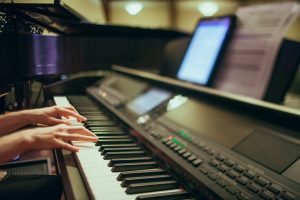
Several digital pianos feature a design that is more or less similar to an acoustic piano. For instance, take a look at the body style of a grand piano.
Digital pianos make use of an electronically synthesized emulation of a sampled sound which is then amplified with the aid of a loudspeaker. These pianos usually have a semi-weighted or weighted keyboard which attempts to create the feel of an acoustic device.
Although digital pianos sometimes fail to recreate the feel offered by an acoustic piano, they offer numerous advantages over acoustic models. Digital pianos are less expensive when compared to acoustic ones. Most digital piano models are much lighter and smaller when compared to acoustic versions. There is no need to tune digital pianos and their tuning can as well be altered for matching the tuning of other instruments.
As digital pianos produce electronic sounds, the volume can be made softer or louder with the aid of volume control. These can be connected to a PA system or the keyboard amplifier for producing a large sound enough to be audible in a large venue. These can as well be played by connecting to headphones, which implies that these will be quiet enough whilst practicing in a hotel room or an apartment.
Some digital piano models can emulate other sounds such as that of an electric piano, Hammond organ, or a pipe organ besides the regular piano. Digital pianos are most often used for amateur performances and in schools for replacing traditional models.
A digital piano is available in a wide variety of sizes, varieties, and shapes. There are two broad categories of digital pianos: stage pianos and console pianos. Console pianos offer a learning suite, a cabinet, and built-in speakers for people who use them in their homes. Stage pianos are used commonly by bands for stage performances. They do not come with built-in speakers or a cabinet. Go through the subsequent sections to know more about the kinds of digital pianos available and their uses.
Types of Digital Piano
So you have made up your mind to purchase a digital piano, but have been worried about the mind-boggling array of brands, prices, and types of the digital piano being offered. Here are the various types of digital pianos and their common uses which can help you to pick the right kind for your needs.
1. Upright Digital Pianos
These pianos are ideal for players at any level. These resemble a piece of furniture and are designed for home use. The traditional cabinet design is much more popular when it comes to upright digital pianos, and these models come with a built-in music desk, an integral stand with pedals and backboard, and a lid. Those who prefer a modern look can opt for the contemporary cabinet design where the lid serves as a music rack when it is kept open. When the lid is closed, it covers the keyboard as well. This offers a low profile and sleek appearance. Upright digital pianos are also known as compact pianos as these occupy less floor space.
2. Portable Digital Pianos
These models more or less resemble an upright digital piano. The only difference is that these do not come with a cabinet. Portable digital pianos are easy to store when not in use. This piano can be placed on a stand when not in use. The speaker system is present within the piano and not in any cabinet. This renders it low in weight and ensures portability. This, however, comes at the expense of the quality of sound. An upright digital piano, on the other hand, has better speakers that are placed on an integral stand. The music desk and sustain pedal in this model are usually detachable.
3. Stage Digital Pianos
These pianos have a more robust body, are heavier, and can withstand the stress of gigging. Generally, stage pianos do not come with inbuilt speakers as they are coupled to a PA system or a keyboard amplifier. Moreover, a stage piano comprises features that are specifically aimed at live keyboard players such as the ability to blend and mix lots of sounds at once, create your own sounds, the ability to edit, and the ability to have better control over other keyboards within a rig. These digital pianos have not been built for use in homes. These are built for use on a stage during a performance.
4. Grand Digital Pianos
Grand digital pianos appear more classic and offer all the features of an upright digital piano. The bigger cabinet promises the best sound possible. This traditional beauty, however, demands high maintenance. These are susceptible to changes and require constant tuning.
Top 5 Reasons to Buy a Digital Piano
Digital pianos offer numerous advantages over traditional ones. A digital piano of higher quality offers features such as realistic sound quality, reverb effects, and weighted keys. Here are the top reasons why you must invest in a digital piano.
1. Convenience
The key reason why many people opt for a digital piano is that it offers convenience to the users. These are much more compact and lighter than acoustic ones. Although the console models come with a cabinet resembling a traditional model, it weighs lesser than their acoustic counterparts. Digital pianos which are apt for use during live performances can be fitted easily in a vehicle and can be carried around wherever you want to. Digital pianos are predominantly made from plastic and are much lighter than the traditional ones which are made from metal and heavy wood.
2. Price
Digital pianos cost lesser than traditional pianos and moreover, the maintenance costs are significantly lower. For instance, the users would never need a tuner and will not have to pay for it.
- Best Digital Pianos Under $500
- Best Digital Pianos Under $700
- Best Digital Pianos Under $1000
- Best Digital Pianos Under $1500
- Best Digital Pianos Under $2000
3. Volume
A traditional piano is capable of generating a volume range based on how hard a musician strikes the keys. The piano volume in a digital version can be controlled much easier. The users can connect headphones to most of the models which in turn permits them to practice silently. This is indeed a blessing for those who do not wish to disturb others in the family or while practicing in a hotel. Digital pianos come with integrated sound sets which permit one to add percussion, drum, woodwinds, and many other sounds to the performance.
4. Recording Capability & Connectivity
Most digital pianos permit the users to record their performance, which can be beneficial to beginners who are just learning to play the instrument. These can easily review their performances by doing so. The sequencing capabilities make digital pianos beneficial over acoustic ones. Most digital pianos can be linked to computers with the aid of a MIDI link [Muscial Instrument Digital Interface]. Certain models as well come with a USB port that enables the users to link them with other devices such as flash memory cards for storing or transferring information.
5. Learning/Teaching Tools
Digital pianos have been designed for beginners and include exercises, built-in lessons, metronomes, chord/note displays, and much more. The tools as well offer access to online resources. Certain models come with dual headphone jacks which permits the teachers and the students to work together. Several digital pianos play featured songs that can serve as a reference guide for beginners.
Check out: How to Improve Piano Skills Without a Teacher?
Now let’s jump to the factors that will help you buy the best digital piano of 2023.
Factors to Consider Before Buying a Digital Piano
Digital pianos are far lighter, cheaper, and packed with incredible features when compared to an acoustic models. Unlike the Casio keyboards of the 90s, the top digital pianos feature beautiful sound quality, realistic reverb effects, and fully-weighted keys. You need to be careful while making a purchase as there is a lot of difference between an actual digital piano and an imitation electronic keyboard. Here are the key parameters that you need to consider while actually purchasing the best digital piano.
1. Number of Keys
Stick to the 88 key version which is the standard for all pianos unless you are a digital artist working on a keyboard workstation or are a DJ.
2. Look for features
While making a purchase, do look into the speaker set-up. Check whether there are any external-facing speakers. Will the piano require an amplifier? Does it have ports compatible with your computer? Is there any headphone jack? Make sure to verify what you are getting for the investment that you are planning to make. All this will help you choose the best digital piano.
3. Fully-weighted
A good digital piano will imitate an acoustic very piano closely. If you find a piano being marketed as “weighted” then rest assured that you are on firmer musical ground. It is pointless opting for a partially weighted version. There is a wide range of options available in the weighted category as well and you need to ensure that you spend some time looking into the features. The best pianos weigh the bass notes a bit heavily, which imitates the larger strings and hammers found in the lower octaves of a piano. Considering these simple aspects can be beneficial as these make a lot of difference over time.
4. Does it sound impressive?
The best digital pianos come for a hefty price and may cost 1000 dollars in excess as opposed to the basic models. The higher-range pianos obviously sound good as these come with built-in speakers and make use of better sound samples. Not all models come with inbuilt speakers.
Hence, you need to connect your digital piano with external amplifiers or to a pair of headphones. Although all models sound good from a distance, you need to spend some time and focus carefully. Models that fall under the lower price category produce a muddier sound. This should not bother you if you are a beginner.
The best digital pianos are capable of replicating the sounds just perfectly in all the registers. They are brighter in the higher registers and punchier in the bass. Just listen to the sound and ask yourself these questions: Do the high notes seem bright? Are the bass notes clear? Does the sound decay in a natural manner? Does the piano sound realistic? If you are willing to pay more, then you can expect some great sound effects from your instrument.
5. Is the instrument portable?
You now know the difference between a grand and an upright piano. You must be aware of the space that each model occupies. It would be a mammoth task if you want to move the instrument for one reason or the other. If size matters to you as well as the portability, then consider stage pianos. These resemble an electronic keyboard and are your best bet if you are looking for something portable and easily affordable. These have been designed to be light in weight and also offer you 88 keys and greater piano action.
6. Consider the price factor
This is something that is dependent on your budget. If you are a beginner, then you can purchase an entry-level model that does not cost you much yet offers you numerous opportunities to learn the basics clearly. A lot of people who purchase a digital piano are basically those who have already taken piano lessons. Ultimately, everything is dependent on how much you are willing to spend.
- Best Digital Pianos Under $2000
- Best Digital Pianos Under $1000
- Best Digital Pianos Under $500
- Best Keyboards Under $300
Your skill level and experience play a crucial role while making a purchase as well. If you are a beginner then you would certainly want to purchase a model that offers built-in tools. An advanced or intermediate pianist would be more selective about the velocity sensitivity and the touch response. Do check the dimensions of the piano before making a purchase. Make sure that it fits into the space where you are planning to keep it during practice. Check the weight if you are looking for the best portable digital piano.
How Our Digital Piano Reviews Will Help You?
Our best digital piano reviews equip buyers while making their shopping decision. Having insightful and clear product reviews of various digital pianos in hand will make the buyers the right decision based on their requirements. Our reviews are authentic and thereby they offer much-needed confidence to the buyers regarding a particular purchase.
With thousands of products available in the marketplace, it offers a tough time for those interested in purchasing a digital piano. Online reviews offered by us sway the decision of the shoppers, thereby ensuring that they get what they are looking for.
Product reviews are extremely important and are influencing. It is vital to check product reviews online before making any purchase rather than repenting later on. Our digital piano reviews are extremely clear and offer in-depth information about the offerings in a particular digital piano model. These as well highlight the products with the same features offered by different brands. This as well helps with the price comparison.
Our product reviews are written by experts in the field who possess the right knowledge about digital pianos. The products are tested by our experts in the field who then come up with a detailed review of a particular model. Our digital piano reviews help people to differentiate between various models which otherwise would not have been possible. Beginners can make proper use of the information that we offer in our reviews about the various models available so that they do not end up making a wrong purchase.
Digital piano reviews offered by us help in identifying product features that can have a significant impact on the decision of buyers. Trustworthy content is the key to unlocking the confidence of the buyers. This is the reason why we try to preserve authenticity while offering product reviews to people.
We ensure transparency while offering information to the buyers. This will help the buyers in making the right move whenever they have to purchase a particular model of digital piano that we have to offer. We do not believe in tricking a customer into making a purchase from our store. Our motto is to equip a purchaser with the most accurate information possible, which helps them to make a purchase with much confidence. So go and check out the list of best digital pianos in the world to make the right choice.
Acoustic Vs. Digital Piano: How to Choose?
Whether you intend to purchase your first piano or are a professional looking to expand your collection, you may at some point wonder whether it would be the right move to purchase a digital piano or an acoustic one. It is no wonder that the touch and tone of an acoustic piano would be far superior to a digital one. However, digital pianos are easier to transport, are smaller, and are less expensive. People need to consider the lifestyle, location as well maintenance that would be required while determining the right piano for an individual.
Opt for a digital version if you are looking for instrumental sounds
If you want to add instruments to your accompaniment such as percussion, woodwinds, and strings, then you need to opt for a digital piano. They come with different sounds such as organ, harpsichord, and many more instrument sounds.
Pick a digital piano if you want to record your music
Many digital pianos come with the option of recording music while you are playing. This is an ideal option for songwriters as they can plug into the computer to access the recorded file.
Opt for acoustic piano if you want more octaves and sound resonance
These have superior sound resonance because of the reverberations created while playing the instrument. These replicate the notes well. However, there is a lack of string resonance. Digital pianos produce fewer overtones and subtleties. Digital pianos have only five or four octaves whereas acoustic ones have six. Opt for an acoustic piano if the music you play usually has a wide range of notes.
Opt for an acoustic piano if you live in a climate-controlled environment
An acoustic piano requires an environment that has low humidity. Digital piano does not come with such requirements.
Opt for a digital piano if you need a quiet instrument
If you live with others or want to practice in a hotel room, then you would need an instrument that comes with volume keys or headphone output. This is possible in a digital piano as the players can hear themselves play without bothering their roommates or neighbors.
Choose an acoustic piano if you have lots of space
Acoustic pianos take up a lot of space. A digital piano is ideal for smaller spaces and moreover, these are available in a range of sizes. If you want to transport your instrument easily, then choose a digital piano. These are easier to handle when compared to acoustic ones as they are lighter. Acoustic pianos are heavy and weigh between 400 to 1000 pounds.
Choose an acoustic piano if you are planning for an investment
The value of an acoustic piano is far better when compared to a digital piano. An acoustic piano is sturdy in construction and can last for decades. Some models gain value over time. However, a digital piano can last for just five years. With continuous improvements in technology, its value would only deteriorate with time.
Choose a digital piano if you are looking for a less maintenance instrument
Digital piano does not come with strings and hammers. Hence it demands lesser maintenance when compared to an acoustic model. Moreover, you do not have to tune it often and can thus save a lot of money on professional tuning.
Check out: How to Clean Piano Keys and Keyboards?
Stick to a digital piano if you want to spend less money on a musical instrument
If you opt for an upright piano, then you can expect to invest $3,500 to $10,000. A simple digital piano would cost you just $200 and the better models would cost somewhere between $1,000 and $3,000.
Choose a digital piano if you are a beginner
Beginners are often confused about the kinds of musical instruments that they need to purchase. Those who lack experience in using any kind of musical instrument need to opt for a digital piano. This is because you need not read music in order to learn the notes. Digital pianos come with the option of pressing the lit keys for following a song. Many models even have notes labeled which make it quite easier to learn to play this instrument.
Considering the above-mentioned factors will help you make the right move when it comes to purchasing a piano. This will help you get a better value for your investment and would also fit your requirements.
Terminology for Digital Pianos
There are a lot of terminologies associated with digital pianos. You must be aware of these if you wish to purchase one. Being clear about these terminologies will help you make the right decision while making a purchase. This is because you would be able to better understand the offerings of a manufacturer while reading a label or a review as you would be aware of what they mean.
Musical Instrument Digital Interface [MIDI]
This is more of a communication protocol employed by every manufacturer which is virtually used in every digital keyboard and piano. Every digital piano offered by Roland comes with MIDI. Roland is the company that invented this very technology. The key advantage of MIDI is that one can link several sound modules and keyboards together with it. The pianist can create an enormous sound bank by accessing all the sounds. The MIDI keyboard can as well be connected to a computer for recording or for taking a printout of musical scores.
Sequencer
This is more of a multi-track recorder. The emergence of software sequencers has eliminated the need for an onboard sequencer. You can interface your software sequencer to your keyboard for multi-track recording if your piano has a MIDI connection. Full-featured sequencers permit quantizing, editing, copying, modifying control changes, and deleting. This permits you to edit your ideas and sequences from the beginning to the end.
Polyphony
Polyphony refers to the maximum number of simultaneous notes that can be generated by a keyboard. For instance, if you play a C major chord, then three notes are in use. Several pianos vary from 32 to 128 voices in polyphony. If you are a professional who does a lot of multi-tracking and sequencing, then it is better to get a keyboard that offers a minimum of 64 voices of polyphony. Exceeding the polyphony results in the voices getting cut in an abrupt manner.
Auto Accompaniment
This feature is responsible for producing a rhythmic, albeit rather than a simple pattern. This can as well produce a chordal accompaniment.
AWM Technology
AWM stands for Advanced Wave Memory. This method has been developed by Yamaha for capturing a sound sample from an acoustic instrument.
Voice
This term has been coined by Roland for a sound or an instrument with a keyboard. If a manufacturer of a digital piano says that 300 vices have been included in it, then it simply implies that 300 different instruments are linked to that piano. Several pianos come with 8 choices of sound or voices.
Flash Drive
This is a removable or portable memory device that permits one to store performances or compositions for easy transfer to a personal computer.
Dual Layer
This feature permits two or more voices to be played simultaneously whenever the keys are pressed by a pianist. Zone panels present on stage pianos permit pianists to edit the voices manually without altering any keyboard settings.
Hammer Effect Keyboard
This digital piano employs hammers that are attached to the keys for replicating the feel of an acoustic piano. It is best to look into the term “weighted action” deeply when specified by a manufacturer.
Reverb
This is responsible for replicating the echo that is responsible for a reduction in the decay of sound. All major concert halls put in a lot of effort towards regulating and perfecting the natural reverb. This is done to prevent the sound from becoming muddy or echoey.
Sound Module
This refers to a huge library of stored voices. This could be linked via MIDI and permits the user to access voices stored in the module. This expands the options presented by the digital piano.
Sampling
This refers to the technology employed for recording an acoustic instrument for storing on a digital instrument.
Touch Sensitivity
This term is closely associated with the term “weighted keyboard”. However, it does not refer to hammer action. Keyboards that come with the touch sensitivity feature are becoming less used in the world of digital pianos.
Synthesizer
A synthesizer has a vast library of sounds and also has features for advanced recording. The synthesizer in Roland Fantom-G has been designed with powerful sequencing software and with advanced computer interactive software.
Split
This permits one to split a keyboard at any time on a digital piano. This helps a pianist play an entirely different instrument by remaining in that specific zone. Digital pianos permit one to split the keyboards basically into two zones. This will help the pianist to play one instrument on one side and another instrument on the other side. It is quite popular these days to split a stage piano into three or more zones.
Supernatural Technology
This technology permits one to pool all the advantages offered by both digital and acoustic pianos into one. Roland brought out the Supernatural piano series on the market during the year 2010. The technology combines 88-key stereo multi-sampling as well as the Roland V-Piano Technology.
This sound engine is a product of the research conducted on the features of all acoustic pianos. Supernatural technology has three parts associated with it: natural decay, multi-sampling, and organic tonal change. This technology is available only in Roland digital pianos as of now.
Some other important terminologies are:
- LCD Display: This display offers relay information to the users
- LED Display: This display offers numerical relay information to the users
- Pedals: There are usually two or three pedals in a digital piano that can be assigned typical functions
- Half pedal: This refers to the ability to mimic the half-way position of a damper pedal, thereby offering better control to a pianist
- Tone Generating Technology: This is basically the technology, which is employed by a manufacturer for generating the sound
- Sustain and Key-off samples: These refer to extra sounds that are used for simulating nuances experienced on an acoustic piano
- Dynamic steps: These refer to the level the degree to which several nuances can be controlled based on the velocity applied to the key
- String Resonance: This refers to the ability to calculate and generate overtones
- Recording Channels: This implies the number of tracks that be recorded
- Transpose: This refers to the ability of a digital piano to be transposed into other keys
- Amplifiers: This refers to the power that is available to the speakers which in turn determines the maximum overall volume. Greater power results in improved sound quality.
- Ensemble Piano: This implies a digital piano, which has the ability to play rhythms along with an auto-accompaniment section.
- Compatible Data Format: This is the format to which the piano adheres for rhythm generation and recording
- Temperaments: This refers to the tuning method employed by a particular digital piano. Equal Temperament is set by default in most the digital pianos
- Master Tuning: This permits the piano to be detuned from the universal concert pitch
- Guide Lamp: A guide lamp refers to small LEDs that are placed just above the keys. They display the notes that are being played currently either by MIDI recordings or by a song demonstration system
- Music Clips: These are hooks or clips that are found at the base of the music desk and help in keeping the pages open
- Headphone Hanger: This refers to a hanger on a cabinet that permits a pianist to store the headphones when not in use. This helps you to prevent misplacing your headphones after a session or when not in use.
Questions to Ask When Choosing a Digital Piano
Purchasing a piano is more like making an investment. It requires a careful understanding of the instrument in order to make a confident move regarding a purchase. Moreover, it is vital to be aware of your need before planning a purchase. Are you a beginner or are you a professional? Are you looking for a portable instrument or are you looking for a piano that is backed by the latest technology?
Several questions arise in the minds of individuals who are planning to purchase a digital piano. You certainly need to find an answer to all the questions before proceeding with a purchase.
Here is a list of vital questions that one needs to ask themselves before purchasing a digital piano:
- What features of a digital piano would benefit me the most?
- What is my skill set?
- What purpose would this purchase serve?
- How much can I spend on this purchase?
- Is the instrument that I am considering touch sensitive?
- How many voices does this piano offer?
- Are the keys noisy?
- What is the maximum polyphony offered by this digital piano?
- Will this piano fit in the space where I intend to practice?
- Will I have to travel with this instrument?
- Does this digital piano come with speakers and built-in amplifiers?
- What accessories are offered with this digital piano?
- What are the tools or accessories that I need to purchase with this instrument?
- Is this piano loud enough?
- What is the warranty offered on this digital piano?
- What is the return policy on this piano?
- How is the customer service offered by this company when compared to others?
So, that’s it. We have given you the list of best digital pianos 2023 as well as a buyer’s guide, so it’s up to you how better you can understand the buying guide and read reviews to pick the best digital piano.


